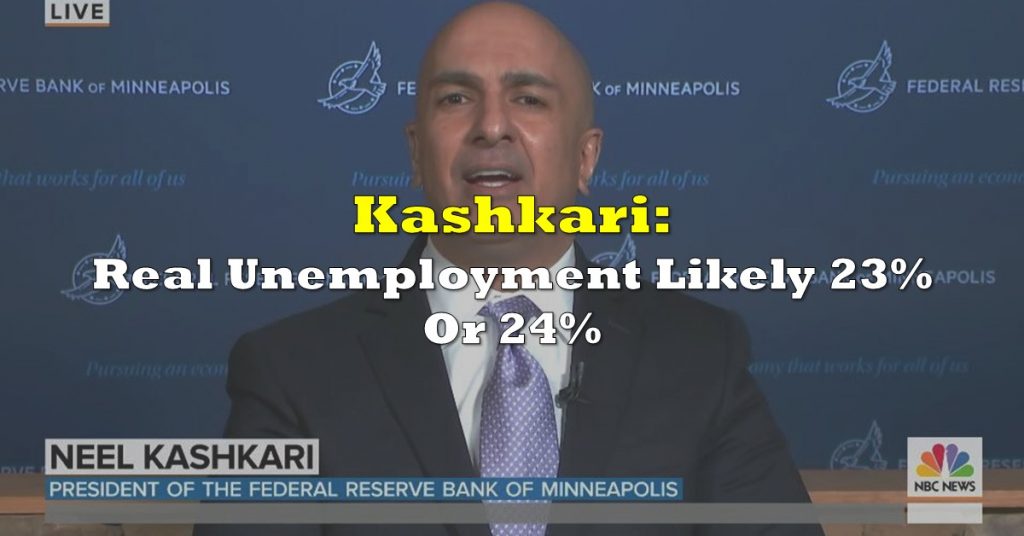Despite the continued chaos in the US regarding soaring coronavirus infection rates and hospitalizations, it appears the economy may be beginning to show signs of improvement. The US Bureau of Labour Statistics (BLS) released their Employment Situation report for the month of June, which shows nonfarm payrolls increased by 4.8 million. Although the numbers pave the way for the potential of a V-shaped recovery, the BLS has also in the meantime inconspicuously admitted its household survey is riddled with survey errors that have been skewing the results since May. So then, what is really going on?
According to the BLS household survey and the establishment survey, nonfarm payrolls increased by 4.8 million since May, thus reducing the June unemployment rate by 2.2% to 11.1%. The total number of unemployed Americans fell by 3.2 million to 17.8 million, but June’s unemployment numbers are still up by 7.6% when compared to February data. Nonetheless, the number of individuals who want a job but are currently not in the labour force fell by 767,000 to 8.2 million since May; however, the numbers are still still above the February data by 3.2 million.

Despite the coronavirus pandemic significantly impacting the travel and hospitality industry, June’s employment numbers are suggestive of an emerging rebound. According to the BLS report, employment related to leisure and hospitality rose by 2.1 million, while employment in food services and drinking establishments increased by 1.5 million. However, the numbers still remain below their February level by approximately 1.3 million.
With respect to the retail industr,- especially brick-and-mortar stores which suffered a blow amid nationwide lockdown measures and stay-at-home orders, the incoming employment data is also suggestive of a prospective rebound. For the month of June, employment related to retail trade increased by 740,000, with the most prominent gains stemming from clothing and clothing accessories stores. Albeit the increase was larger by 368,000 compared to May data, the total employment in the retail industry is less than February’s numbers by 368,000.
Furthermore, employment levels in the manufacturing sector increased by 356,000, but are still short by 757,000 since February. The construction industry saw 158,000 worth of job gains, while transportation and warehousing employment increased by 99,000 for the month of June. Education and health services reported a rebound of 568,000, but still a significant 1.8 million below February numbers.
Despite job increases across many sectors in June, the month also saw a decline in hourly wages and workweek durations. According to the BLS, the average workweek for private nonfarm positions fell by 0.2 hours to 34.5 hours. Given that the manufacturing is beginning to get busy with a resumption of consumerism coinciding with the lifting of restrictions, the industry saw an increase of 0.5 hours to a total of 39.2 hours.
In the meantime, the average hourly wages for private nonfarm employees dropped by $0.35 to $29.37. According to the BLS, the sudden decline in average hourly wages can be attributed to the concentration of incoming job gains amongst the lower-paid workers. The shift towards a greater portion of lower-paid positions is in turn pulling the average downward.
Although the latest data in The Employment Situation report is certainly painting a hopeful outlook for the US economy, it does come riddled with several shortcomings. Also inconspicuously mentioned in the report, the BLS admits to a survey error that led to the misclassification of May’s unemployment rate, causing it to be approximately 3% lower than the actual rate. Apparently household survey interviewers did not correctly classify some individuals under the unemployed or temporarily laid off category, which in turn caused the unemployment rate to be lower.
Although the BLS determined that there was an error with the household survey in May, the error still persists, even in June’s data. The BLS stated that although they are aware of the continued misclassification, the actual unemployment rate for June may be only 1% higher than the reported one. Nonetheless, the BLS accepts the misinterpreted data in its statistical calculations, for the apparent sake of data integrity… whatever that means.
Information for this briefing was found via the US Bureau of Labour Statistics. The author has no securities or affiliations related to this organization. Not a recommendation to buy or sell. Always do additional research and consult a professional before purchasing a security. The author holds no licenses.









